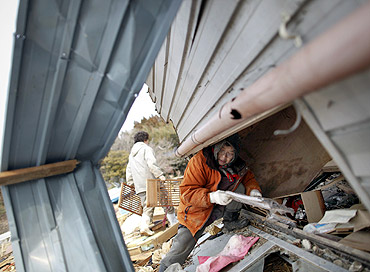 | « Back to article | Print this article |
Damaged reactor at nuke plant worries Japan
Concerns over more serious contamination mounted in Japan on Friday as authorities said the core of one of the six reactors at the Fukushima nuclear plant may have been damaged, a day after three workers were exposed to high radiation while trying to stabilise the crippled unit.
The radiation leak detected at the No.3 reactor indicated possible damage to the unit's vessel, pipes or valves, Japan's Nuclear and Industrial Safety Agency said, two weeks after the magnitude 9 quake and tsunami rocked the country's northeast, leaving over 27,000 people dead or unaccounted for.
"At present, our monitoring data suggest the (No.3) reactor retains certain containment functions, but there is a good chance that the reactor has been damaged," Hidehiko Nishiyama, spokesman for the agency, told a press conference.
Two workers suffer radiation burns
Three workers at the No.3 reactor's turbine building were on Thursday exposed to the water containing radioactive material 10,000 times the normal level. Two of them were hospitalised with possible radiation burns to their feet.
Nishiyama said the high-level radiation is suspected to have originated from the reactor where overheating fuel rods are believed to have been partially melted, or a boiling pool that stores spent nuclear fuel, both of which are located in the same building.
Following the incident, the nuclear agency ordered the Tokyo Electric Power Company, the operator of the nuclear plant, to improve radiation management at the crisis-hit facility. TEPCO has already begun removing the highly radioactive water from the site.
Release of radioactive material to continue
Nishiyama said that further verification is needed to find out how the radioactive water reached the underground site. Tonnes of water had been poured into the reactor and in its pool, which was substantially damaged by a hydrogen blast on March 14.
The government, which had earlier designated areas within a 20 km radius of the Fukushima plant as exclusion zone, on Friday encouraged residents within a 30 km radius of the nuclear power station to leave voluntarily, as the release of radioactive material is expected to continue for some time.
Though the restoration work at the troubled plant was disrupted due to the radiation exposure incident on Thursday, TEPCO prepared to inject fresh water into the No.1, No.2, No.3 and No.4 reactor cores and spent fuel pools, instead of seawater which is being currently used.
People living within 30 kms asked to leave
Authorities wanted to replace sea water with fresh water as crystallised salt could form a crust on the fuel rods and prevent smooth water circulation, thus diminishing the cooling effect.
Defence Minister Toshimi Kitazawa said that United States forces in Japan will offer fresh water to be sprayed at the reactor cores and the fuel pools to ensure ample water supply.
TEPCO currently uses fresh water from a dam near the plant.
Chief Cabinet Secretary Yukio Edano said that heads of affected municipalities within 20 to 30 km of the nuclear plant have been told to encourage people to voluntarily move further away.
'Distribution of goods is stalled'
Edano said it is "preferable" for people to leave, given the difficulties they are encountering in their daily lives.
"The distribution of goods is stalled, and it is rather difficult to maintain their daily living over a long period of time," he was quoted as saying by Kyodo.
Locals staying indoors are facing a hard time procuring a range of goods. Trucking companies are also shunning the government-designated areas apparently due to fears of radiation exposure.
Thousands still missing
Two weeks after the devastating March 11 earthquake and tsunami, nearly 240,000 people are still being sheltered in 1,900 evacuation centres. Damage to houses and roads is estimated between 16 trillion to 25 trillion yen.
According to the National Police Agency, more than 27,000 people are confirmed dead or remained unaccounted for -- 10,035 killed and 17,443 missing.
Miyagi police have posted on their website information about more than 2,000 recovered bodies, including details of clothing and body type, in the hope of identifying them.
Japan Meteorological Agency warns of another quake
In view of a large number of bodies, Miyagi and Iwate prefectures are forgoing the custom of cremating them and have begun burials. In Higashimatsushima, Miyagi, nearly 100 bodies have been buried so far, Kyodo said.
While highways and ports in the disaster-hit areas have reopened, part of the bullet train service on the Tohoku Shinkansen Line is still suspended.
Survivors of the disaster also experienced continuous aftershocks, with the Japan Meteorological Agency forecasting a 20 per cent likelihood through Sunday of a quake with a magnitude of over 7.
Radiation levels in tap water decline
Meanwhile, radiation levels in tap water at a Tokyo water purification plant declined further on Friday, remaining within the normal range for consumption.
Authorities detected 51 becquerels of radioactive iodine per litre of water, sampled on Friday morning at the Kanamachi water purification plant in the capital's Katsushika Ward.
The figure is below 100 becquerels, the central government's safe limit for consumption by infants. It is also below the safe limit for adults at 300 becquerels, the local government was quoted as saying.







